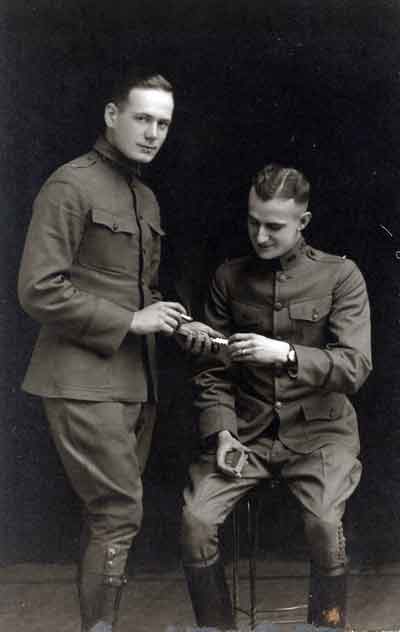Wabash Men in History: A Sure Magicby Jon Pactor ’71 |
| Printer-friendly version | Email this article |
|
Long before he reached the age of 39, Kenyon Nicholson ’17 had embarked on a successful career as a versatile playwright and screenwriter of comedy, romance, and drama connecting him with such immortals as Jimmy Cagney, Humphrey Bogart, Jerry Lewis, Claudette Colbert, and James Dean.
1927 was a fantastic year in American life. Lindbergh flew across the Atlantic, Ruth swatted 60 home runs, and Jolson starred in the first talkie, The Jazz Singer. On January 18, Nicholson’s play The Barker opened at the Biltmore on Broadway. It was one of the longest running plays of its time. He was just 32.
After his service in World War I, Nicholson undertook a variety of tasks, most notably as a professor of playwriting at Columbia University from 1924 to 1929.
Prior to the Barker, he had written several pieces, often with collaborators, including S. N. Behrman. After the Barker, his career took off with plays for the stage, screenplays for Hollywood, and plays for radio and television. He often wrote with others and has been called a “master collaborator.”
It does not appear that he wrote any play based upon his life as a member of Beta Theta Pi, despite the plot of the Barker, which launched Colbert to stardom. Carnival barker Nifty Miller wants his son Chris, 19, not to join the carnival but have a better life as a wealthy and respectable lawyer. To persuade his father to let him work the carnival during the summer, Chris promises to return to school in the fall and eventually become a lawyer. “If I’m goin’ to be a lawyer—don’t you think I gotta know somethin’ about life?,” he successfully pled his case. He stays on and learns something about life, as he marries the snake charmer whose age “if ye go by experience is 120.”
But among the play’s twists and turns, Nifty eventually gets a postcard from Chicago notifying him that his son is working in a law office while his snake-charmer wife dances in a night club to support them. The reviewer in Time Magazine concluded: “[T]he tense emotion, fascinating atmosphere, curious vernacular of the dialogue lend Playwright Nicholson’s creation a sure magic.”
In 1934, Charles Robinson and Nicholson collaborated on the play Sailor Beware, a raucous comedy set in Panama. This play was made into a movie as Nice Goin in 1938, The Fleet’s In in 1942 (with William Holden and Dorothy Lamour), and in 1951 as Sailor Beware, starring Jerry Lewis and Dean Martin. James Dean had a small role.
Nicholson co-authored Taxi, a movie of crime and romance, in 1932. It was a huge box-office hit that boosted the career of Jimmy Cagney who played an independent New York City cabbie who resisted being squeezed out by a taxi cartel. He gets the girl (Loretta Young) and his vindication.
Humphrey Bogart starred as a wrestling promoter in the musical comedy Swing Your Lady, a 1938 movie based on Nicholson’s play. Ronald Reagan had a small role in the movie.
Nicholson was an activist in the Dramatist Guild for many years. The Guild, which still exists, started in 1919 to improve working conditions in the theater and to assist playwrights. Within the Guild, he worked with such luminaries as Irving Berlin, George S. Kaufman, Eugene O’Neill, Clifford Odets, and Moss Hart.
Nicholson was in the forefront of adapting some plays to radio for Theater Guild On The Air, commonly known as the United States Steel Hour. It presented radio plays for nearly 10 years. It was no easy feat because he had to compress the play into a much smaller time frame than the stage would allow and had to make the play come alive without facial expressions, gestures, and postures of the actors on the stage.
He died in 1986. His wife and he had no children, but G.B. Landrigan ’85 was his cousin.
In photo: Nicholson in his WW I uniform with fellow Wabash man Marshall Jones ’17.
|

 His success did not stop there, nor did it begin there. He was born John Kenyon Nicholson in Crawfordsville on May 21, 1894. As a Wabash student, he was active in drama and writing. He won a $100 prize from the famous Hoosier author Gene Stratton Porter in a competition among Wabash students in his sophomore year.
His success did not stop there, nor did it begin there. He was born John Kenyon Nicholson in Crawfordsville on May 21, 1894. As a Wabash student, he was active in drama and writing. He won a $100 prize from the famous Hoosier author Gene Stratton Porter in a competition among Wabash students in his sophomore year.